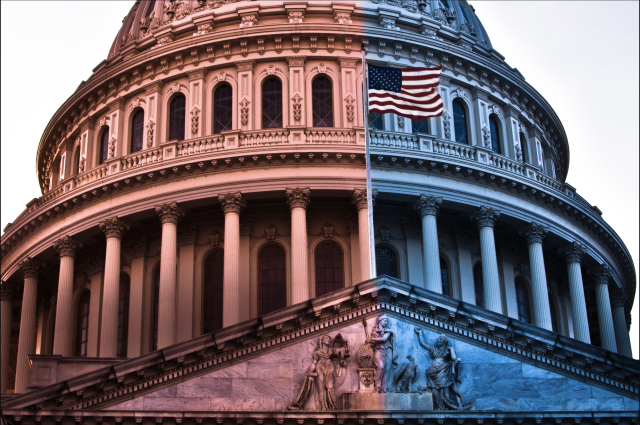ANALYSIS – With just three weeks to go until the U.S. midterm elections, a New York Times/Siena poll of likely voters finds the Republican party is gaining momentum national over the Democrats as concerns over the economy, inflation, illegal immigration, and crime, grow among voters.
When the the Times sounds the alarm, even in an understated way, expect things to be far worse for the Democrats than reported.
But when the Times “Chief Political Analyst” resorts to breaking down the numbers in the most comical and petty way, to lessen the impact on Dems, expect a red wave.
According to this poll, 49% of likely voters plan to vote for a Republican to represent them in Congress on November 8, compared with 45% who plan to vote for a Democrat.
That’s a four-point lead, versus a one-point lead Democrats reportedly had over Republicans just last month, making the total swing in voter preference in just a few months five points.
That’s a significant shift.
Rising inflation and declining stocks are making the economy the number one concern for voters, who believe Republicans are better equipped to deal with these concerns.
And this could mean that not only will the GOP most certainly win back the House but may gain control of the Senate too.
As the New York Times writes:
… [that’s a] notable swing from last month, when Democrats led by one percentage point among likely voters. Since then, the warning signs for Democrats have begun to add up, including Republican polling gains in key Senate races like those in Nevada, Wisconsin and Pennsylvania, and surprising Republican strength in districts in Rhode Island and Oregon where Democrats would normally be safe.
The Times explains that this isn’t a one-off poll:
Republicans have led in several high-quality polls, like ABC/Washington Post, CBS/YouGov and Monmouth University. Today, the Times/Siena survey adds a fourth such poll to the pile.
It adds, as I have predicted it would since the Roe vs Wade reversal:
The evidence for a shift toward Republicans appears to be underpinned by a change in the national political environment. Gas prices went up again. The stock market is down. A variety of data suggests that the electorate’s attention is shifting back to issues where Republicans are on stronger ground in public opinion, like the economy, inflation, crime and immigration, and away from the summer’s focus on democracy, gun violence and abortion, where Democrats have an edge.
In other words, the conditions that helped Democrats gain over the summer no longer seem to be in place.

But America’s “paper of record” can’t help itself so it desperately still tries to spin the narrative in a less damaging light for the Dems.
So, Nate Cohn, The Times’ chief political analyst, formerly with liberal New Republic, then goes on to laughably diminish the GOP four-point advantage into “only” a three-point advantage due to “rounding” of the poll result numbers.
He further goes on to spend a great deal of time discussing the intricacies of polling, and how imperfect polling is.
Something that I totally agree with.
However, this level of inane wonkery to diminish polls showing one party’s advantage nationally is something I’ve never seen in over 30 years of politics.
Meanwhile, many experts point out that the biggest error in polling in today’s political environment is how undercounted conservative Republicans are in the polls.
This was highlighted in a recent Washington Post piece that used Ohio as an example:
A look at the Marist poll’s fine print suggested something that should make Democrats nervous in the run-up to Nov. 8: Pollsters might be seriously undercounting the Republican electorate — specifically, the working-class White voters who were crucial to Trump’s electoral success.
What caught my attention in the poll’s details was the information that 45 percent of respondents had a college degree. A check of the most recent census data indicates that in Ohio, only about 29 percent of the adult population has a bachelor’s degree or higher.
The writer, Mark Weaver, an election law attorney, and communications consultant,adds something I have discussed before – that conservative Republicans and Trump voters have been cowed into silence, but they still vote.
He notes:
This isn’t just about a single poll or a single state. I regularly talk with pollsters and campaigns, and I hear a common lament: Trump voters distrust pollsters and the media that reports on poll results, and simply won’t participate, out of protest or paranoia.
He continues discussing undercounted ‘shy’ or ‘submerged Trump voters’:
Trump supporters might have the added worry of being attacked for frankly stating their views. Stories of those affiliated with Trump being arrested, subpoenaed, doxed or mocked — with Trump providing angry amplification — result in a lower social trust of strangers inquiring about political views.
So, if the the Times “Chief Political Analyst” wanted to be a real polling wonk, perhaps he should ask why the polls have been so wrong about Republicans recently.
And instead of doing intellectual summersaults to diminish a four-point GOP lead, admit the GOP lead is probably MUCH, MUCH, greater.
Opinions expressed by contributors do not necessarily reflect the views of Great America News Desk.





